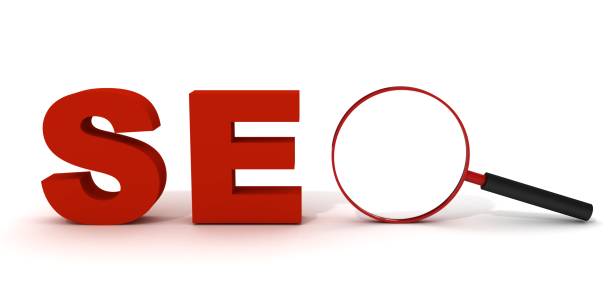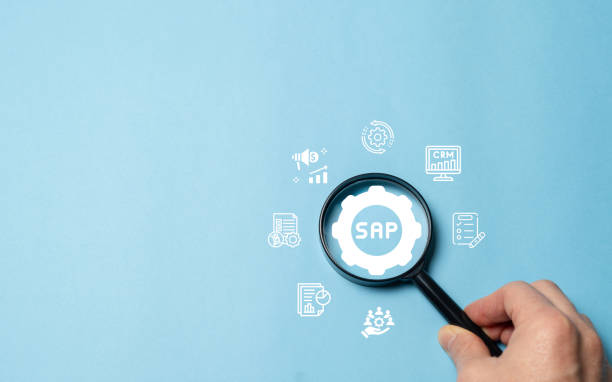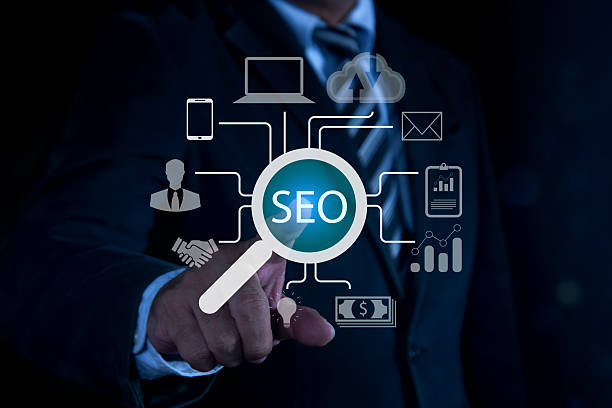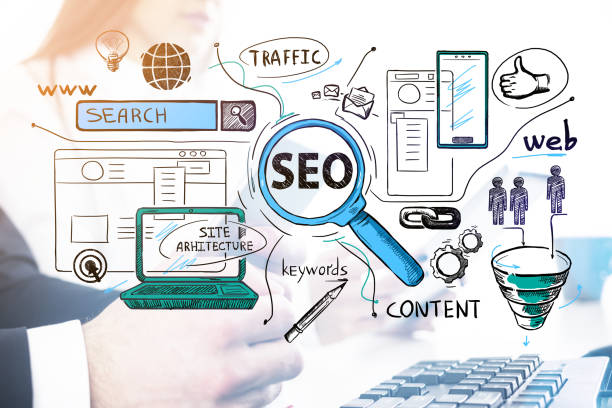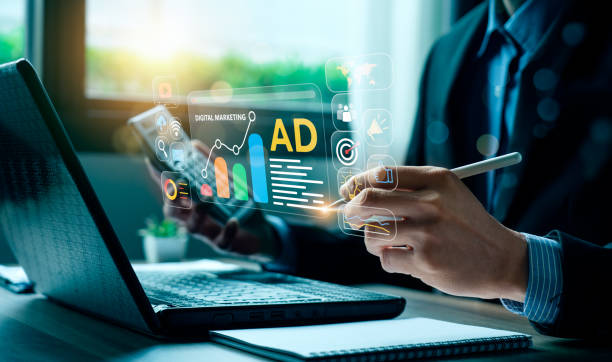What is On-Page SEO and Why is it Important?
On-Page SEO refers to a set of techniques and actions that are performed within your website to improve your site’s ranking in search engine results (like Google).
These actions include optimizing content, site structure, HTML tags, and other website elements.
The importance of On-Page SEO stems from the fact that search engines use these elements to understand the content of your site and relate it to users’ queries.
In other words, On-Page SEO helps you show search engines what your site is about and why they should show it to users.
Without proper On-Page SEO, even with the best content, your site may not be visible in search results and you may lose organic (natural) traffic.
In fact, On-Page SEO is the foundation for #Off-Page_SEO and other online marketing strategies.
Some of the most important aspects of On-Page SEO include:
- Optimizing titles and meta descriptions
- Optimizing page content (using appropriate keywords, readability of text)
- Optimizing URL structure
- Optimizing images (alt tag)
- Optimizing page loading speed
- Using internal and external links
By correctly implementing these techniques, you can improve your site’s ranking in search results and attract more traffic.
Remember that On-Page SEO is an ongoing process and requires continuous updating and improvement.
Are you unhappy with the low sales of your online store?
Rasaweb is your solution for having a professional and high-selling online store.
✅ Significant increase in sales and revenue
✅ Easy and enjoyable shopping experience for customers
⚡ Get a free consultation from Rasaweb right now!
Keyword Research
Keyword research is one of the most important steps in On-Page SEO.
Keywords are phrases that users enter into search engines to find information or products they are looking for.
By researching keywords, you can understand exactly what users are looking for and optimize your site content accordingly.
Click here to preview your posts with PRO themes ››
To start keyword research, you can use various tools such as Ahrefs, Ubersuggest, Google Keyword Planner, and SEMrush.
These tools help you find keywords related to your business, check their search volume, and assess the level of competition for them.
When choosing keywords, consider the following points:
- Relevance: Keywords should be relevant to your site content.
- Search Volume: Keywords should have an acceptable search volume. Words that no one searches for are worthless.
- Competition: Keywords should not be too competitive. High competition makes it difficult to reach high rankings in search results.
- User Intent: Pay attention to the user’s intent when searching for the keyword. Is the user looking for information, or are they intending to buy a product?
After selecting appropriate keywords, use them in titles, meta descriptions, page content, image alt tags, and other elements of your website.
Keep in mind that excessive use of keywords (Keyword Stuffing) can harm your site’s SEO.
Instead, try to use keywords naturally and within the context of the text.
Content Optimization
Content optimization is the beating heart of On-Page SEO.
High-quality and relevant content is not only valuable to users, but also helps search engines understand the topic of your site.
To optimize content, consider the following points:
- Quality: Your content should be valuable, informative, and engaging. Avoid writing duplicate, short, and useless content.
- Relevance: Your content should be relevant to the keywords you have targeted.
- Readability: Your content should be readable and understandable. Use short sentences, organized paragraphs, and subheadings.
- Structure: Your content should have a logical structure. Use Heading tags (H1, H2, H3, etc.) to organize content.
- Keywords: Use keywords naturally in titles, meta descriptions, page content, and image alt tags.
- Images and Videos: Use relevant and high-quality images and videos in your content.
- Updating: Update your content regularly to keep it fresh and relevant.
Click here to preview your posts with PRO themes ››
In addition, pay attention to content length. In general, longer content (over 1000 words) has a better chance of ranking in search results. Of course, content length should not come at the expense of its quality. The most important thing is to provide valuable and relevant content to users.
| Element | Description |
|---|---|
| Page Title (Title Tag) | The main title of the page that is displayed in search results. |
| Meta Description | A brief description of the page content that is displayed in search results below the title. |
| Heading Tags (H1-H6) | Used to organize and structure content. |
| Image Alt Tag | Text description for images that helps search engines understand the content of the images. |
By following these tips and providing quality content, you can improve your site’s ranking in search results and attract more traffic. On-Page SEO plays a vital role in your online success.
URL Structure Optimization
The URL structure of your website plays an important role in On-Page SEO. Clear and descriptive URLs help search engines and users understand the content of the page. To optimize URL structure, consider the following points:
- Short and Concise: URLs should be short and concise. Avoid using unnecessary and lengthy words.
- Descriptive: URLs should clearly describe the content of the page. Use relevant keywords in the URL.
- Readable: URLs should be readable and understandable. Avoid using uppercase letters, numbers, and special characters.
- Consistent: URLs should be consistent with the overall structure of your site. Avoid creating irregular and unstructured URLs.
- Use Hyphens (-): Use hyphens to separate words in the URL.
For example, instead of using incomprehensible URLs like `example.com/page?id=123`, use descriptive URLs like `example.com/blog/seo-internal`. This URL is not only more understandable for search engines, but also helps users know what page they will be taken to when they click on it.
Remember that changing URLs after pages have been indexed can harm your site’s SEO. Therefore, carefully plan the URL structure before publishing pages.
Are you falling behind in competition with large online stores?
Rasaweb, with its professional online store design, brings your business online and increases your market share!
✅ Increased brand credibility and customer trust
✅ Easy shopping experience leading to more sales
⚡ Take action now to get a free website design consultation!
Image Optimization
Images play an important role in attracting and engaging users with your site content. However, images themselves are not understandable to search engines. In order for search engines to understand the content of your images, you need to optimize them. To optimize images, consider the following points:
- File Name: The image file name should be descriptive and relevant to its content. Avoid using default and meaningless names. For example, instead of using a name like `IMG_1234.jpg`, use a name like `seo-internal-guide.jpg`.
- Alt Tag: The image alt tag should provide a brief and accurate description of the image content. This tag helps search engines understand the content of the image and is also shown to users if the image fails to load for any reason.
- File Size: The file size of images should be optimized. Large images can slow down page loading speed. Use image compression tools to reduce file size.
- File Format: Use appropriate file formats for images. JPEG format is suitable for images with many colors, and PNG format is suitable for images with graphics and text.
- Image Dimensions: The image dimensions should be appropriate for its placement on the page. Avoid displaying large images in small sizes.
By following these tips, you can optimize your images for search engines and help your site’s On-Page SEO.
Remember that using high-quality and relevant images not only helps your site’s SEO, but also improves the user experience. A suitable image can make your content more attractive and understandable.
Page Loading Speed
Page loading speed is one of the important factors in On-Page SEO and user experience. Users expect websites to load quickly. If your page loads slowly, users will leave your site, and this can harm your site’s ranking in search results.
Google also values page loading speed as a ranking factor. Therefore, optimizing page loading speed is essential for On-Page SEO. To improve page loading speed, you can use the following techniques:
- Image Optimization: Large images can slow down page loading speed. Use image compression tools to reduce file size.
- File Compression: Compress CSS, JavaScript, and HTML files to reduce their size.
- Using CDN: Use a Content Delivery Network (CDN) to host your static files. CDN allows users to download files from the server closest to them.
- Browser Caching: Use browser caching to store static files in users’ browsers. This makes the page load faster on subsequent visits.
- Reduce HTTP Requests: Reduce the number of HTTP requests. The fewer the number of requests, the faster the page loads.
- Code Optimization: Optimize your HTML, CSS, and JavaScript code. Clean and optimized code increases page loading speed.
To check your page loading speed, you can use tools like Google PageSpeed Insights and GTmetrix. These tools help you identify your site’s weaknesses and take action to improve them.
Remember that improving page loading speed is an ongoing process and requires continuous review and optimization.
Internal Linking
Internal linking refers to the process of creating links between different pages of your website. Internal links help search engines understand the structure of your site and determine the importance of different pages. Also, internal links help users easily navigate your site and access the information they need.
Internal linking is an important strategy in On-Page SEO. By using internal links, you can connect the important pages of your site to each other and improve their ranking in search results. To internal link, consider the following points:
- Relevance: Internal links should be created between relevant pages. Linking a page to a page that has nothing to do with it is not only unhelpful, but can harm your site’s SEO.
- Link Text: Link text (Anchor Text) should be descriptive and relevant to the destination page. Avoid using general text like “Click Here”.
- Number of Links: The number of internal links on each page should be appropriate. Excessive linking can harm your site’s SEO.
- Placement of Links: Place internal links in appropriate places on the page. The best places to place links are in the main text of the page and in the site’s navigation menu.
For example, if you are writing an article about On-Page SEO, you can link to your other articles about Off-Page SEO and keyword research.
Internal linking is an ongoing process and requires continuous review and updating. With proper internal linking, you can improve your site structure, increase user experience, and improve your site’s ranking in search results.
| Link Type | Description | Advantages |
|---|---|---|
| Link to Main Pages | Linking from internal pages to main pages such as the homepage, product page, and service page. | Increase the credibility of main pages, direct users to important pages. |
| Link to Related Pages | Linking from one page to other pages that have related content. | Improve user experience, increase time spent on the site. |
| Link to High-Ranking Pages | Linking from low-ranking pages to high-ranking pages. | Transfer credibility to low-ranking pages, improve overall site ranking. |
Mobile Optimization
With the increasing use of mobile devices to search the internet, optimizing a website for mobile (Mobile-Friendly) has become particularly important. Google also pays attention to this issue and prioritizes mobile-friendly websites in search results. Therefore, if you want to improve your site’s ranking in search results, you need to make sure that your website is optimized for mobile.
To optimize a website for mobile, you can use the following techniques:
- Responsive Design: Use responsive design so that your website automatically adapts to the screen size of different devices.
- Page Loading Speed: Page loading speed on mobile should be fast. Mobile users are usually not patient, and if your page loads slowly, they will leave your site.
- Ease of Navigation: Navigation on the mobile website should be easy and understandable. Use simple menus and large buttons.
- Touchability: Make sure that all elements of your website are touchable on mobile. Buttons and links should be large enough for users to easily touch them.
- No Flash: Avoid using Flash on your mobile website. Flash is not supported on mobile devices and can cause performance issues.
To check the mobile-friendliness of your website, you can use Google’s Mobile-Friendly Test tool. This tool helps you identify problems with your website and take action to fix them. On-Page SEO is incomplete without considering mobile optimization.
Remember that mobile optimization is an ongoing process and requires continuous review and updating. By optimizing your website for mobile, you can increase user experience and improve your site’s ranking in search results.
Is your online store ready to attract maximum customers and increase sales? Rasaweb transforms your online business by designing modern and efficient online stores.
✅ Increased speed and improved SEO
✅ Excellent user experience on mobile and desktop⚡ Get a free online store design consultation from Rasaweb!
Using Schema Markup
Schema markup is structured code that allows you to provide more information about your page content to search engines. By using schema markup, you can help search engines better understand your page content and display it more accurately in search results.
Schema markup can be used for different types of content, including articles, products, events, people, and organizations. By using schema markup, you can provide information such as title, description, rating, price, and product availability to search engines.
Using schema markup can help improve your site’s display in search results. Search engines can use schema markup information to display rich snippets in search results. Rich snippets can help users learn more about your page before clicking on the link, and this can help increase your site’s click-through rate (CTR).
To use schema markup, you can use the Schema Markup Generator tool. This tool helps you generate the schema markup code you need and add it to your page’s HTML code.
On-Page SEO will not be complete if schema markup is not considered. Remember that using schema markup is a technical process and requires programming knowledge. If you are not familiar with coding, you can get help from an expert.
By using schema markup, you can improve your site’s visibility in search results and attract more traffic. On-Page SEO requires attention to every detail.
Measuring and Analyzing Results
On-Page SEO is an ongoing process and requires continuous measurement and analysis. To know how effective your On-Page SEO efforts have been, you need to measure your results and analyze them. By measuring and analyzing results, you can identify the strengths and weaknesses of your strategy and take action to improve it.
To measure and analyze On-Page SEO results, you can use various tools such as Google Analytics and Google Search Console. These tools help you collect and analyze information such as site traffic, keyword rankings, click-through rate (CTR), and conversion rate.
By using Google Analytics, you can understand which sources users are coming to your site from, which pages they spend the most time on, and what behaviors they perform on your site. By using Google Search Console, you can understand which keywords your site is displayed in search results with, what is your site’s ranking for each keyword, and what errors exist on your site.
By analyzing this information, you can identify the strengths and weaknesses of your On-Page SEO strategy and take action to improve it. For example, if you notice that your site’s ranking for a particular keyword is low, you can optimize the content of the relevant page or do more internal linking. On-Page SEO always needs review and correction.
Remember that measuring and analyzing results is an ongoing process and should be done regularly. By measuring and analyzing results, you can ensure that your On-Page SEO strategy is effective and helps you achieve your goals.
Frequently Asked Questions
| Question | Answer |
|---|---|
| What is On-Page SEO? | On-page SEO involves optimizing elements that are directly in your control and within your website. Its goal is to help search engines better understand the content of the page and improve its ranking. |
| Why is On-Page SEO important? | On-page SEO gives search engines clear signals about the content of the page, improves user experience, and increases the chance of attracting organic traffic. |
| What are the most important On-Page SEO factors? | Keywords, Title Tag, Meta Description, URL structure, high-quality content, image optimization, and internal links are among the most important factors. |
| What is the role of the Title Tag in On-Page SEO? | The title tag is one of the most important signals for search engines and users, which specifies the main topic of the page. It should include the main keyword and be attractive. |
| How important is the Meta Description? | Meta descriptions do not directly affect ranking, but they can improve click-through rate (CTR) by encouraging users to click. |
| How to optimize images for On-Page SEO? | By using a descriptive file name, appropriate Alt Text containing keywords, compression to reduce size, and correct dimensions. |
| What is the effect of Internal Links on SEO? | Internal links help search engines discover and index site pages, distribute credibility (PageRank) throughout the site, and improve user navigation. |
| Is page loading speed one of the On-Page SEO factors? | Yes, page loading speed is a critical factor in On-Page SEO and user experience. Slower pages can lead to higher bounce rates and lower rankings. |
| What are the characteristics of high-quality content for On-Page SEO? | High-quality content should be comprehensive, unique, relevant, reliable, readable, and fully answer users’ needs and questions. |
| How can keywords be used in content? | Keywords should be used naturally in the title, subtitles, first paragraph, body text, and alternative text of images. Avoid keyword stuffing. |
And other services of Rasa Web Advertising Agency in the field of advertising
Smart custom software: A professional solution for analyzing customer behavior with a focus on dedicated programming.
Smart Google Ads: A combination of creativity and technology to increase sales by optimizing key pages.
Smart Social Media: A professional solution for increasing click-through rate with a focus on dedicated programming.
Smart Marketplace: Designed for businesses looking to increase sales by customizing the user experience.
Smart UI/UX: A new service to increase online growth through SEO-focused content strategy.
And more than hundreds of other services in the field of internet advertising, advertising consulting and organizational solutions
Internet Advertising | Advertising Strategy | Advertorial
Resources
What is On-Page Optimization? Ahrefs Guide
, The Complete Guide to On-Page SEO
,On-Page Optimization | MOZ SEO Guide
,On-Page SEO: The Complete Guide
? Are you ready to transform your business in the digital world? Rasaweb Afarin Digital Marketing Agency, with its expertise in professional website design and SEO, offers innovative solutions for your growth and visibility.
📍 Tehran, Mirdamad Street, next to the Central Bank, Southern Kazerun Alley, Ramin Alley, No. 6
“`


